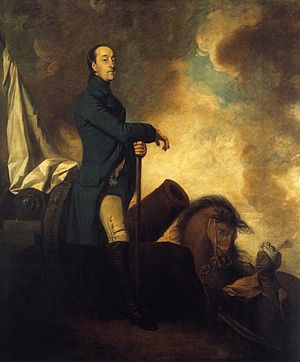Spanish invasion of Portugal (1762)
| Spanish invasion of Portugal | |||||||
|---|---|---|---|---|---|---|---|
| Part of the Seven Years' War | |||||||
 The Count of Schaumburg Lippe, commander of the Anglo-Portuguese forces that thrice defeated the Spanish and French offensives against Portugal. Painting by Joshua Reynolds. |
|||||||
|
|||||||
| Belligerents | |||||||
|
|
|
||||||
| Commanders and leaders | |||||||
|
|
|
||||||
| Strength | |||||||
| 7-8,000 Portuguese 7,104 British |
42,000 men, including 10-12,000 French (the largest Spanish military mobilisation of the eighteenth century). | ||||||
| Casualties and losses | |||||||
| Very low: (14 British soldiers killed in combat and 804 by disease or accidents; Portuguese losses low.) | 25,000 men (killed by hunger, combat or disease; desertion and prisoners) | ||||||
Decisive Anglo-Portuguese victory:
The Spanish invasion of Portugal between 5 May and 24 November 1762 was a main military episode of the wider Seven Years' War, where Spain and France were heavily defeated by the Anglo-Portuguese Alliance (including broad popular resistance). It initially involved the forces of Spain and Portugal, before the French and British intervened in the conflict on the side of their respective allies. The war was also strongly marked by a national guerilla warfare in the mountainous country, cutting off supplies from Spain and a hostile peasantry that enforced a scorched earth policy as the invading armies approached, leaving the invaders starving and short of military supplies.
During the first invasion, 22,000 Spaniards commanded by Nicolás de Carvajal, Marquis of Sarria, entered the Province of Alto Trás-os-Montes (northeast of Portugal) having Oporto as their ultimate goal. After occupying some fortresses, they were confronted with a national uprising. Taking advantage of the mountainous terrain, the guerrilla bands inflicted heavy losses on the invaders and practically cut off their communication lines with Spain, causing a shortage of essential supplies. Near starvation, the Spaniards tried to conquer Oporto quickly, but were defeated in the battle of the Douro and at Montalegre before retreating to Spain. After this failure, the Spanish commander was replaced by Pedro Pablo Abarca de Bolea, Count of Aranda.
Meanwhile, 7,104 British troops landed in Lisbon, leading a massive reorganization of the Portuguese army under the Count of Lippe, the supreme allied commander-in-chief.
During the second invasion of Portugal (Province of Beira), 42,000 Franco-Spaniards under Aranda took Almeida and several other strongholds, while the Anglo-Portuguese army stopped another Spanish invasion of Portugal by the province of Alentejo, attacking at Valencia de Alcántara (Spanish Extremadura), where a third Spanish corps was assembling for invasion.
...
Wikipedia
